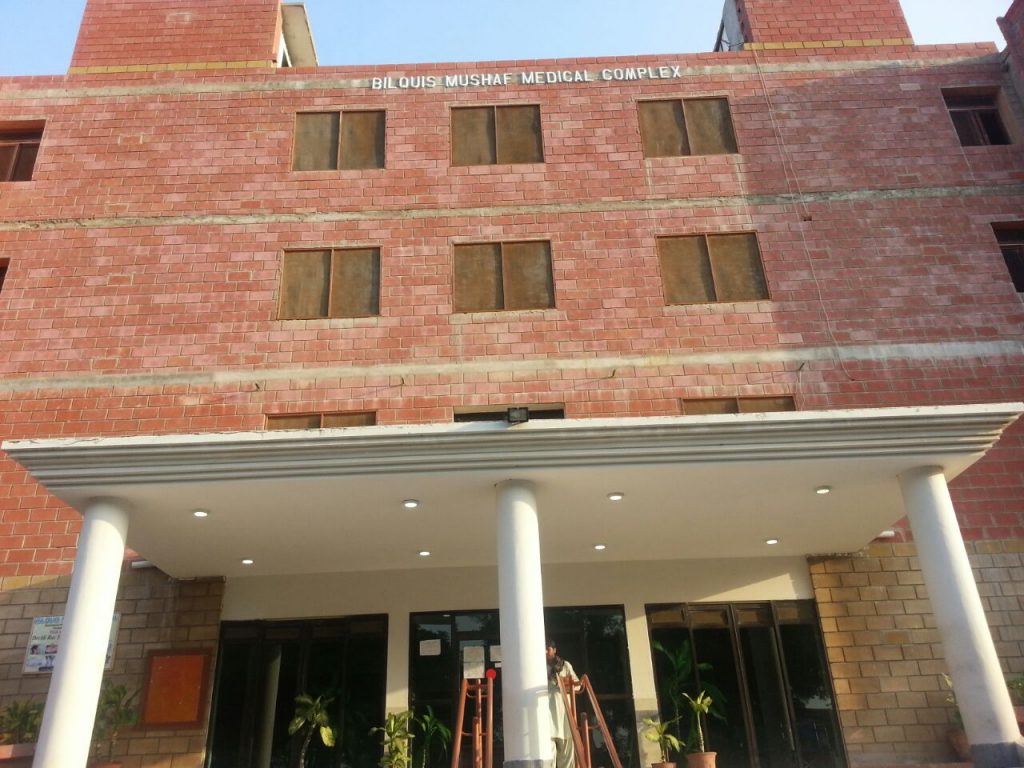Overview and Objectives
In May 20th 2017, the Sawayra team visited Rashidabad as part of finalizing the designing and commissioning plan for solar power at Bilquis Mushaf Hospital. The team was led by Mr Aurangzaib Khan, Operations Manager, who was supported by Ali Shehryar. There were also four Sawayra interns, all full time students at NED students:
- Imran Zammarrud
- Jawad Javed
- Samreena
- Sidra Hussain (Group lead)
Also part of the trip were two representative from Orient Energy Systems, Ltd., the contractor hired by Sawayra to implement the Solar power project. The Sawayra team had the following objectives for the trip:
- Measurements of roof area per its civil layout
- Verification of counting of lights and fans in basement
- Selection of a temperature controlled area for the placement of inverter and breakers
- Meeting with the students of Hunar foundation
- Understanding the connections through main distribution panel
- Verifying the connections of breakers to load (lights and fans) in rooms
- Discussion on wiring of load to connect it with inverters
- Inquire about internet connection
Activities
At the hospital, the following tasks were carried out:
- Measurements of roof area: Firstly, interns (guided by surveying team of Orient) took measurements of roof area on civil layout. During these measurements, trainee electricians from Hunar Foundation also took part.
- Verified the count of lights and fans in basement: Total number of energy saver bulbs = 60 bulbs. Total number of ceiling fans = 34. Total number of wall mounted fans = 10
- Selection of suitable area for placement of the batteries and inverters: Batteries and inverters need to kept at place where temperature variations are not rapid and controlled to ±5 with 25°C. For that, a place near window on third floor has been decided.
- Understanding the load distribution through main distribution box: Each floor in the hospital is provided the three-phase connection and having two main breakers for one each floor. There isn’t any redundant connection to distribute the solar load directly through MDB.
- Checked breaker connections to rooms through sub distribution panel: Each room in basement was tested by putting off and on its breaker from sub distribution panel so as to verify that the load connected on individual breaker for a room is only lights and fans.
- Discussed separate wiring to lights and fans for connection with solar panels: Separate wiring from each room’s switch board (containing only lights and fans) will be laid for connection with inverters
- Meeting with Hunar Foundation (www.hunarfoundation.org) leadership. Sawayra has a MOU with Hunar to develop solar power installation, troubleshooting and maintenance curriculum that will be taught as part of their Electrician Course, and made available via Sawayra’s website.
Technical Topics
Solar Panels:
For the project, thirty six pieces of CS6X-P 300W Canadian Solar panels will be used by Orient Energy. Canadian Solar was founded in 2001 in Canada and is one of the largest manufacturers of panels in the world with 6GW of modules deployed worldwide. They are headquartered out of California and are listed as a publicly traded company on the NASDAQ stock market exchange. The efficiency of these polycrystalline silicon panels is about 16% at 25C, with about 9% loss in rated output when the temperature increases to 45C, which is possible during summer days in Tando Allah yar. The manufacturers’s specification has the panel’s rated output drop by no more than 10% in the first 10 years, and no more than 10% in the next twenty five years, so that the panel will produce at least 80% of rated power. The Canadian Solar panel has IP rating 65, and according to IEC standard 60259, the panel has complete protection against dust. It is completely packed and protected. However, the exterior of the panels needs to be kept clean and should not be shaded. Also, the back of the panel should not be blocked or covered, so natural convection cooling is not inhibited.
The panels were available in Orient Energy stock, as part of their effort to provide good turnaround on solar projects in Pakistan and Middle East. The team compared the Canadian Solar panels with mono crystalline silicon panels from ReneSola, which is an American brand with similar warranty as Canadian Solar. Renesola has 14GW of solar products installed worldwide, but we not selected due to cost and lead times.
During summer, we should get about five equivalent hours of sunlight each day, so 10.8kW of solar panels should produce over 50kWh of energy on a clear day, with panels pointing towards the southern sky at an angle of elevation of about 25 degrees. System losses typically average about 20%, and will be validated during installation. Specifically twenty four 2V- 800Ah Vision batteries will be used.
Batteries
In order to provide power during evening, rechargeable batteries are part of the system design. Since lead acid batteries require maintenance in terms of adding distilled water at periodic intervals, sealed batteries of both the AGM and Gel variety were considered. Between these, the costs are similar, but the charging rate is faster for AGM. For solar applications, Lithium based batteries have also been considered, as they can give three to five times longer life, but, they cost several times more than
Answer:
Battery:
Hour rate
As per the calculations the battery ampere hour rate is calculated as :
Amp-hrs=
(Total battery back up )
(Depth of discharge)(nominal voltage)(efficiency of the battery)(Number of cells used)
Total battery backup= Battery backup in the morning +Battery backup at night Total battery backup= (23×25+40×100)(2) +(23×25+8×100)(7) = 18775 W
Depth of discharge=60% Efficiency of battery excluding 15% losses= 85% No. of cells=24
Amp-hrs=
(18775)
(0.6)(2)(0.85)(24)
= 766.9 Amp − hr ≅ 800 Amp-hr
From these calculations 24 of CL series 800 Amp-hr batteries were used.
Types of cells
AGM v/s Gell batteries
To reduce maintenance VRLA (Valve regulated lead acid batteries are used) that can be mounted in any orientation. These batteries have two types AGM and Gel batteries.
AGM batteries are a type of VRLA battery in which the electrolyte is held in the glass mats, as opposed to freely flooding the plates. These batteries ae spill proof increasing the impact resistance and lowering the internal resistance. At the lower resistance the output voltage increases that in turns reduces losses to heat as power flows increasing the charging time [7] The charging rate is 5 times faster of AGM batteries than that of Gel batteries [5] They have the ability to deep cycle and are utilized in applications in which bursts of high amp current are required during charge or discharge. The internally generated gases are recombined with the liquid which result in no loss of electrolyte and no corrosion. The life expectancy is improved if the battery is not discharged below 60% [6]
Gel batteries provide with less power on same size of the AGM battery. They require a regulator and regular maintenance. Gel batteries offer slow discharge rate at a slightly higher ambient temperature [6] These batteries can not endue high amperage or faster charging discharging that can pull apart the jelly in the battery which may lead to corrosion of the plates [7]
Conclusion
Regarding the cost to power output ratio and observing a depth of discharge which is suitable to the system designed i.e. 60% AGM type batteries are preferred.
Battery specifications
• Deep cycle dry cell battery is used instead of flooded batteries as flooded batteries are not sealed and exhaust the internally generated gases increasing the chance of corrosion of plates and maintenance due to loss of electrolyte. Flooded batteries are used for high torque loads and deep cycle dry cell batteries are used for constant loads [7]
• The battery used is of version C10 i.e. the battery’s life reduces if it is completely discharged over the period of 10 hours. Industrial consumers use C10 batteries due to larger load. And residential consumers use C20 versions due to lesser loads comparatively.
• Referring to the Self discharge characteristic curve in the specification sheet [8] of battery an increment of 10℃ reduces the storage months by half i.e. the life of battery is reduced to half on 10℃ increase. For this reason battery needs proper ventilation or a room with exhaust mechanism. It can also be placed underground in order to protect against temperature.
• The 24 pcs of batteries with nominal voltage 2V is used instead of 4 batteries of each 12 V because a 2V battery consists of one lead plate enclosed in the casing. A 12 V battery has more number of plates that increases the internal resistance and reactive losses per plate which eventually effects the life of the battery.
• Question: General overview of invertor, charge controller and mate 3?
Answer:
Inverter:
Charging Power
Referring the specification sheet of the invertor the charging power is [9]:
Maximum Input AC current= 50 Amp AC output voltage =230 V Charging power= 230x 50 = 11.5kW
The charging power of the invertor is higher than the battery which is (2V x 80Amp )(24) = 4.2 kW because the rectifying circuits inside the invertor are huge and consume more power.
Charge Controller
MPPT v/s PWM
Maximum Power Point Transfer are charge controllers that can be used with voltage inputs greater than voltage levels of battery bank. The MPPT converts the over voltage to amperage that reduces the charging time of the battery keeping the power output stable [10]
Additionally MPPT inhibit any reverse current flow. When solar panels are not generating power at night, the current might flow to the panel back discharging the battery in the case of PWM. Whereas MPPT detects when no energy is produced by the panel and open circuit it to avoid reverse current flow[10]
MPPT also reduces power loss. A lower voltage flow between the solar panels to charge controller will produce greater energy losses which is observed in PWM that that not invite larger voltages. Whereas the MPPT controller can have input voltage higher than battery bank by which the losses in the wire between the panel and controller is less. The over voltage is then converted to amperage inside the controller charging the battery faster [10]
Conclusion MPPT charge controller is used to maintain safe charging of the batteries
System controller:
Remote monitoring is achieved by integrating MATE3 and HUB4 that receive generation data and display on MATE3. This information can be communicated with an individual computer or through wireless network.
There are certain configurations in setting up remote monitoring of the solar system as per the Outback Power Systems MATE3 Owner’s Manual




